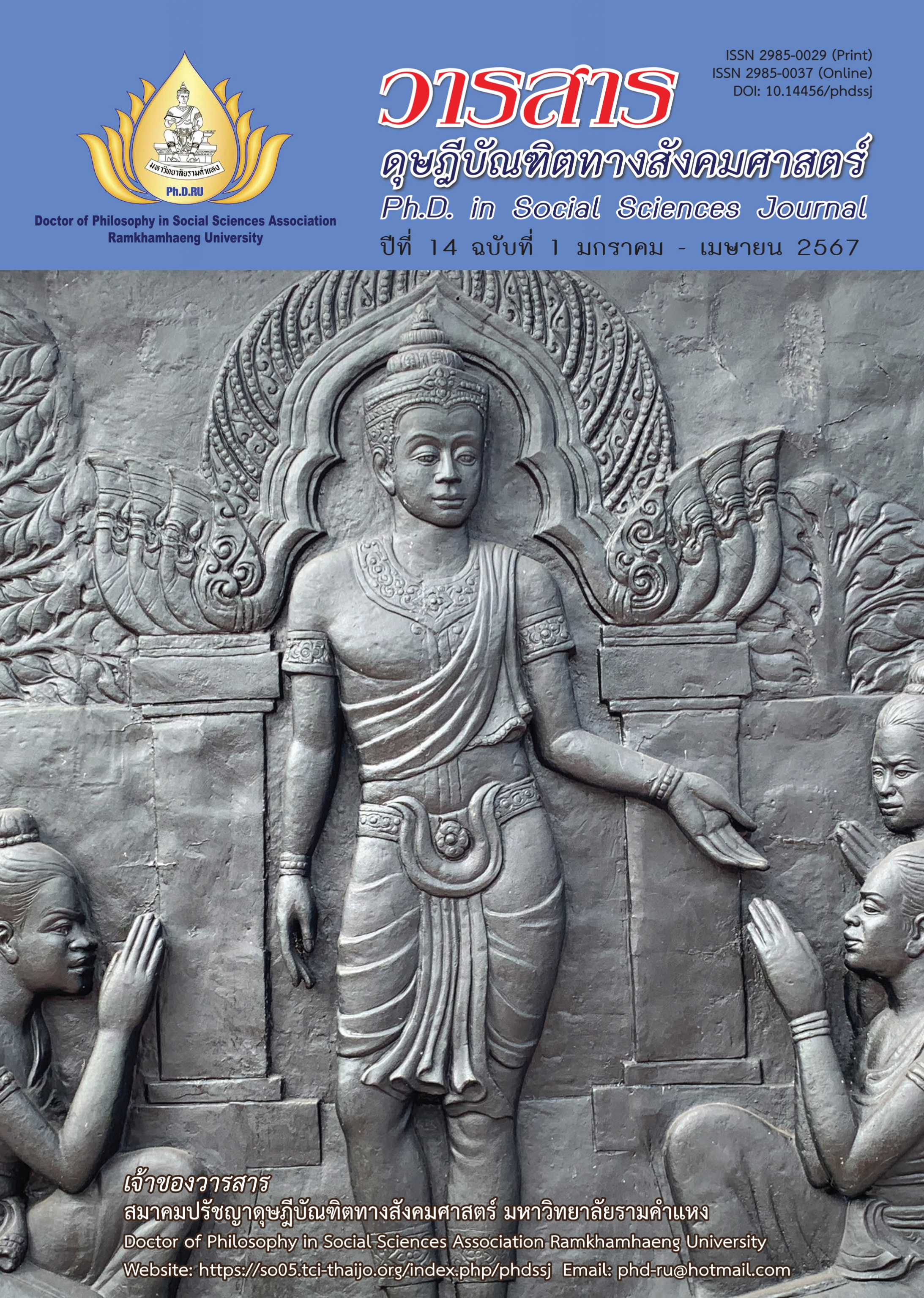รูปแบบความสัมพันธ์เชิงโครงสร้างที่อธิบายอิทธิพลของการจัดการเชิงกลยุทธ์ ความสามารถในการตอบสนองและฟื้นตัวขององค์กร และความได้เปรียบทางการแข่งขันต่อการเติบโตของวิสาหกิจขนาดกลางและขนาดย่อมกลุ่มธุรกิจผู้ให้บริการด้านบูรณาการระบบอัตโนมัติในประเทศไทย
Main Article Content
บทคัดย่อ
บทความวิจัยนี้มีวัตถุประสงค์เพื่อ (1) พัฒนาและตรวจสอบรูปแบบความสัมพันธ์เชิงโครงสร้างที่อธิบายอิทธิพลของการจัดการเชิงกลยุทธ์ และ (2) ศึกษาอิทธิพลของการจัดการเชิงกลยุทธ์ ความสามารถในการตอบสนองและฟื้นตัวขององค์กร และความได้เปรียบทางการแข่งขันที่มีต่อการเติบโตของวิสาหกิจขนาดกลางและขนาดย่อมกลุ่มธุรกิจผู้ให้บริการด้านบูรณาการระบบอัตโนมัติในประเทศไทย เป็นการวิจัยเชิงปริมาณ ใช้แบบสอบถามรวบรวมข้อมูลจากกลุ่มผู้ประกอบการธุรกิจให้บริการด้านบูรณาการระบบอัตโนมัติ จำนวน 250 ราย วิเคราะห์ข้อมูลด้วยค่าเฉลี่ย ส่วนเบี่ยงเบนมาตรฐาน การวิเคราะห์ตัวแบบสมการโครงสร้าง และทดสอบสมมุติฐานโดยใช้โปรแกรมทางสถิติ
ผลการวิจัย พบว่า ผลการวิเคราะห์องค์ประกอบเชิงยืนยันของตัวแปรพบว่ามีความสอดคล้องกลมกลืนกับข้อมูลเชิงประจักษ์ พิจารณาจากค่า χ² มีค่าเท่ากับ 107.823 df เท่ากับ 112 χ²/df มีค่าเท่ากับ 0.962 RMSEA มีค่าเท่ากับ 0.000 TLI มีค่าเท่ากับ 1.002 CFI มีค่าเท่ากับ 1.000 และ SRMR มีค่าเท่ากับ 0.039 ตามลำดับ ผลการทดสอบสมมุติฐาน พบว่า การจัดการเชิงกลยุทธ์ มีอิทธิพลทางตรงต่อความได้เปรียบทางการแข่งขันและความสามารถในการตอบสนองและฟื้นตัวขององค์กร ความสามารถในการตอบสนองและฟื้นตัวขององค์กรมีอิทธิพลทางตรงต่อความได้เปรียบทางการแข่งขันและการเติบโตของธุรกิจ และความได้เปรียบทางการแข่งขันมีอิทธิพลทางตรงต่อการเจริญเติบโตของธุรกิจ สรุปว่า ทุกปัจจัยมีอิทธิพลต่อการเจริญเติบโตของธุรกิจดังสมมุติฐานที่ตั้งไว้
Article Details

อนุญาตภายใต้เงื่อนไข Creative Commons Attribution-NonCommercial-NoDerivatives 4.0 International License.
บทความวิชาการ บทความวิจัย และบทวิจารณ์หนังสือในวารสารดุษฎีบัณฑิตทางสังคมศาสตร์ เป็นความคิดเห็นของผู้เขียน มิใช่ของคณะผู้จัดทำ และมิใช่ความรับผิดชอบของสมาคมปรัชญาดุษฎีบัณฑิตทางสังคมศาสตร์ มหาวิทยาลัยรามคำแหง (กรณีการทำวิจัยในมนุษย์ ผู้วิจัยต้องผ่านการอบรมจริยธรรมการวิจัยในมนุษย์ และนำหลักฐานมาแสดง)
เอกสารอ้างอิง
Andrews, P. D. (2020). Women-owned small businesses: The impact of social networks on small business growth and leadership development in a global marketplace. Doctoral Dissertation in Global leadership and Chang, Pepperdine University.
Brown, C., Seville, E., & Vargo, J. (2017). Measuring the organizational resilience of critical infrastructure providers: A New Zealand case study. International Journal of Critical Infrastructure Protection, 18, 37-49.
Chen, X. (2012). Impact of business intelligence and IT infrastructure flexibility on competitive advantage: An organizational agility perspective. The University of Nebraska-Lincoln.
Department of Industrial Promotion. (2021). Registrant SI. Retrieved from https://www.diprom-si.net/ [In Thai]
Duchek, S. (2014). Growth in the face of crisis: The role of organizational resilience capabilities. In Academy of Management Annual Meeting Proceedings (pp. 861-866). Faculty of Business and Economics, TU Dresden, Germany.
Dyer, J. H., Godfrey, P., Jensen, R., & Bryce, D. (2016). Strategic management: Concepts and tools for creating real world strategy. Wiley & Sons.
Fosfuri, A., Giarratana, M. S., & Roca, E. (2016). Social business hybrids: Demand externalities, competitive advantage, and growth through diversification. Organization Science, 27(5), 1275-1289.
Frese, M. (2000). Success and failure of micro business owners in Africa: A psychological approach. Praeger.
Geiser, C. (2012). Data analysis with Mplus. Guilford Press.
Gökdeniz, I., Kartal, C., & Kömürcü, K. (2017). Strategic assessment based on 7S McKinsey model for a business by using analytic network process (ANP). International Journal of Academic Research in Business and Social Sciences, 7(6), 342-353.
Hair, J. F., Black, W. C., Babin, B. J., & Anderson, R. E. (2010). Multivariate data analysis (7th ed.). Pearson.
Kantur, D., & Say, A. I. (2015). Measuring organizational resilience: A scale development. Journal of Business Economics and Finance, 4(3), 456-472.
Kaplan, R. S., & Norton, D. P. (1992). The balanced scorecard: Measures that drive performance. Harvard Business Review.
Kelloway, E. K. (2015). Using Mplus for structural equation modeling: A researcher’s guide (2nd ed.). Sage.
Lassila, A. (2006). Offering software as a service: Case study of system integrators. In European Conference on Information Systems (pp. 1-12). Association for Information Systems.
Meijaard, J., Brand, M. J., & Mosselman, M. (2005). Organizational structure and performance in Dutch small firms. Small Business Economics, 25, 83-96.
McManus, S., Seville, E., Vargo, J., & Brunsdon, D. (2008). Facilitated process for improving organizational resilience. Natural Hazards Review, 9(2), 81-90.
Ministry of Industry (Thailand). (2016). Thailand industrial 4.0 development strategy 20 years (2017-2036). Retrieved from http://www.oie.go.th/sites/default/files/attachments/industry_plan/thailandindustrialdevelopmentstrategy4.0.pdf [In Thai]
Nidumolu, S. R., & Knotts, G. W. (1998). The effects of customizability and reusability on perceived process and competitive performance of software firms. MIS Quarterly, 22(2), 105-137.
Njeru, K. N., & Kariuki, P. (2019). Influence of mckinsey framework on competitive advantage of firms in the telecommunication industry in Kenya. Journal of International Business, Innovation and Strategic Management, 3(1), 68-81.
Nunnally, J. C., & Bernstein, I. H. (1994). The assessment of reliability. Psychometric Theory, 3, 248-292.
Office of the National Economic and Social Development Council. (2017). National strategy 20 years (2018-2037). Retrieved from https://www.nesdc.go.th/main.php [In Thai]
Ogundana, O. (2020). Factors influencing the business growth of women-owned sewing businesses (WOSBs) in Lagos-State, Nigeria: A gender-aware growth framework. Nottingham Trent University.
Pantaweesak, N. (2019). Are Thai system integrators ready for manufacturing industry in the digital age and AI?. Retrieved from https://shorturl.asia/CEK9x [In Thai]
Porter, M. E. (1985). Competitive strategy: Techniques for analyzing industries and competitors: With a new introduction. The Free Press.
Porter, M. E. (2005). The competitive advantage creating and sustaining superior performance. The Free Press.
Qing, C. (2015). Driving business growth in the information economy: New perspectives from technology vendors and entrepreneurial ventures. Doctoral Thesis of Philosophy, National University of Singapore.
Rouse, M. (2018). Definition system integrator. Retrieved from https://searchitchannel.techtarget.com/definition/systems-integrator
Rudolph, J. W., & Repenning, N. P. (2002). Disaster dynamics: Understanding the role of quantity in organizational collapse. Administrative Science Quarterly, 47(1), 1-30.
Rajpatty, S. (2011). Integrating TQM methods with corporate strategy: A source of sustainable competitive advantage. Sheffield Hallam University (United Kingdom).
Sharma, S., & Sharma, S. K. (2020). Probing the links between team resilience, competitive advantage, and organizational effectiveness: Evidence from information technology industry. Business Perspectives and Research, 8(2), 289-307.
Silpcharu, T. (2017). Research and data processing with SPSS and AMOS (18th ed.). Chulalongkorn University Press. [In Thai]
Singh, A. (2013). A study of role of McKinsey’s 7S framework in achieving organizational excellence. Organization Development Journal, 31(3), 39-50.
Wang, J., & Wang, X. (2019). Structural equation modeling: Applications using Mplus. John Wiley & Sons.
Waterman, R. H., Peters, T. J., & Phillips, J. R. (1980). Structure is not organization. Business Horizons, 23(3), 14-26.
Webb, B., & Schlemmer, F. (2006). Resilience as a source of competitive advantage for small information technology companies. In IFIP International Federation for Information Processing (pp. 181-197). Springer.
Xiao, L., & Cao, H. (2017). Organizational resilience: The theoretical model and research implication. In ITM Web of Conferences (pp. 1-4). EDP Sciences.


